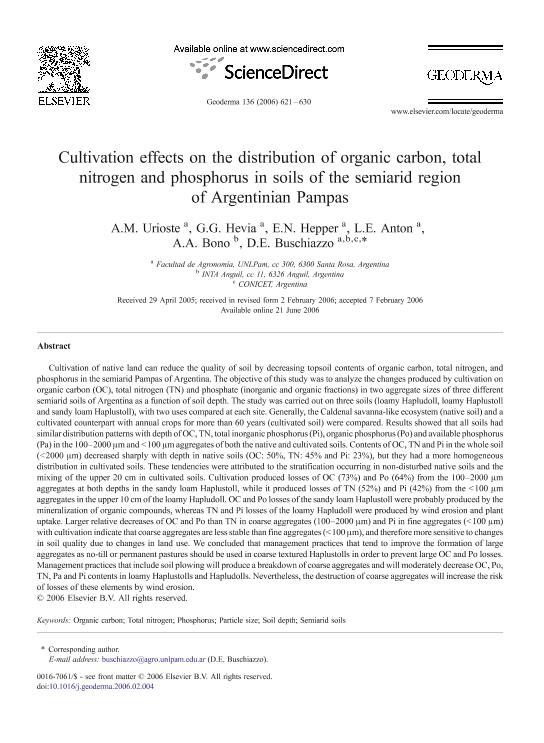Mostrar el registro sencillo del ítem
dc.contributor.author
Ana María, Urioste

dc.contributor.author
Hevia, Graciela Gloria

dc.contributor.author
Hepper, Estela Noemí

dc.contributor.author
Anton, L. E.
dc.contributor.author
Bono, A. A.
dc.contributor.author
Buschiazzo, Daniel Eduardo

dc.date.available
2019-08-16T18:29:44Z
dc.date.issued
2006-12
dc.identifier.citation
Ana María, Urioste; Hevia, Graciela Gloria; Hepper, Estela Noemí; Anton, L. E.; Bono, A. A.; et al.; Cultivation effects on the distribution of organic carbon, total nitrogen and phosphorus in soils of the semiarid region of Argentinian Pampas; Elsevier Science; Geoderma; 136; 3-4; 12-2006; 621-630
dc.identifier.issn
0016-7061
dc.identifier.uri
http://hdl.handle.net/11336/81742
dc.description.abstract
Cultivation of native land can reduce the quality of soil by decreasing topsoil contents of organic carbon, total nitrogen, and phosphorus in the semiarid Pampas of Argentina. The objective of this study was to analyze the changes produced by cultivation on organic carbon (OC), total nitrogen (TN) and phosphate (inorganic and organic fractions) in two aggregate sizes of three different semiarid soils of Argentina as a function of soil depth. The study was carried out on three soils (loamy Hapludoll, loamy Haplustoll and sandy loam Haplustoll), with two uses compared at each site. Generally, the Caldenal savanna-like ecosystem (native soil) and a cultivated counterpart with annual crops for more than 60 years (cultivated soil) were compared. Results showed that all soils had similar distribution patterns with depth of OC, TN, total inorganic phosphorus (Pi), organic phosphorus (Po) and available phosphorus (Pa) in the 100-2000 μm and < 100 μm aggregates of both the native and cultivated soils. Contents of OC, TN and Pi in the whole soil (< 2000 μm) decreased sharply with depth in native soils (OC: 50%, TN: 45% and Pi: 23%), but they had a more homogeneous distribution in cultivated soils. These tendencies were attributed to the stratification occurring in non-disturbed native soils and the mixing of the upper 20 cm in cultivated soils. Cultivation produced losses of OC (73%) and Po (64%) from the 100-2000 μm aggregates at both depths in the sandy loam Haplustoll, while it produced losses of TN (52%) and Pi (42%) from the < 100 μm aggregates in the upper 10 cm of the loamy Hapludoll. OC and Po losses of the sandy loam Haplustoll were probably produced by the mineralization of organic compounds, whereas TN and Pi losses of the loamy Hapludoll were produced by wind erosion and plant uptake. Larger relative decreases of OC and Po than TN in coarse aggregates (100-2000 μm) and Pi in fine aggregates (< 100 μm) with cultivation indicate that coarse aggregates are less stable than fine aggregates (< 100 μm), and therefore more sensitive to changes in soil quality due to changes in land use. We concluded that management practices that tend to improve the formation of large aggregates as no-till or permanent pastures should be used in coarse textured Haplustolls in order to prevent large OC and Po losses. Management practices that include soil plowing will produce a breakdown of coarse aggregates and will moderately decrease OC, Po, TN, Pa and Pi contents in loamy Haplustolls and Hapludolls. Nevertheless, the destruction of coarse aggregates will increase the risk of losses of these elements by wind erosion.
dc.format
application/pdf
dc.language.iso
eng
dc.publisher
Elsevier Science

dc.rights
info:eu-repo/semantics/openAccess
dc.rights.uri
https://creativecommons.org/licenses/by-nc-sa/2.5/ar/
dc.subject
Organic Carbon
dc.subject
Particle Size
dc.subject
Phosphorus
dc.subject
Semiarid Soils
dc.subject
Soil Depth
dc.subject
Total Nitrogen
dc.subject.classification
Ciencias del Suelo

dc.subject.classification
Agricultura, Silvicultura y Pesca

dc.subject.classification
CIENCIAS AGRÍCOLAS

dc.title
Cultivation effects on the distribution of organic carbon, total nitrogen and phosphorus in soils of the semiarid region of Argentinian Pampas
dc.type
info:eu-repo/semantics/article
dc.type
info:ar-repo/semantics/artículo
dc.type
info:eu-repo/semantics/publishedVersion
dc.date.updated
2019-08-15T16:04:22Z
dc.journal.volume
136
dc.journal.number
3-4
dc.journal.pagination
621-630
dc.journal.pais
Países Bajos

dc.journal.ciudad
Amsterdam
dc.description.fil
Fil: Ana María, Urioste. Universidad Nacional de La Pampa. Facultad de Agronomía; Argentina
dc.description.fil
Fil: Hevia, Graciela Gloria. Universidad Nacional de La Pampa. Facultad de Agronomía; Argentina
dc.description.fil
Fil: Hepper, Estela Noemí. Universidad Nacional de La Pampa. Facultad de Agronomía; Argentina
dc.description.fil
Fil: Anton, L. E.. Universidad Nacional de La Pampa. Facultad de Agronomía; Argentina
dc.description.fil
Fil: Bono, A. A.. Instituto Nacional de Tecnología Agropecuaria. Centro Regional La Pampa-San Luis. Estación Experimental Agropecuaria Anguil; Argentina
dc.description.fil
Fil: Buschiazzo, Daniel Eduardo. Instituto Nacional de Tecnología Agropecuaria. Centro Regional La Pampa-San Luis. Estación Experimental Agropecuaria Anguil; Argentina. Consejo Nacional de Investigaciones Científicas y Técnicas. Instituto de Ciencias de la Tierra y Ambientales de La Pampa. Universidad Nacional de La Pampa. Facultad de Ciencias Exactas y Naturales. Instituto de Ciencias de la Tierra y Ambientales de La Pampa; Argentina
dc.journal.title
Geoderma

dc.relation.alternativeid
info:eu-repo/semantics/altIdentifier/doi/https://doi.org/10.1016/j.geoderma.2006.02.004
dc.relation.alternativeid
info:eu-repo/semantics/altIdentifier/url/https://www.sciencedirect.com/science/article/pii/S0016706106001480
Archivos asociados
